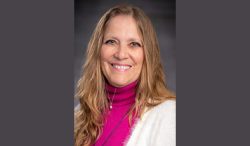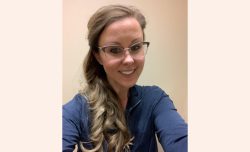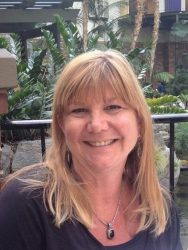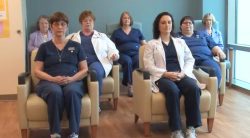Creating Favorable Conditions in Orlando

In October, just before Hurricane Matthew threatened Orlando, Florida, the organizers of the annual Magnet conference—the most prestigious and highly attended nursing conference in the USA—invited us to speak on the benefits of the TM program for nurses. Our conference presentation topic was: “Pilot study of the Effects of Transcendental Meditation on Compassion Fatigue and Resiliency Among Nurses.”
Magnet Hospitals
There are 389 Magnet hospitals in the US. That represents less than 1% of US hospitals. The MAGNET designation represents the highest award that a hospital can receive for nursing excellence. The award is given by the American Nurse Credentialing Center (ANCC) and lasts for 4 years.
Part of the Magnet Mission Statement says: “A Magnet hospital is stated to be one where nursing delivers excellent patient outcomes, nurses have a high level of job satisfaction and where there is a low staff nurse turnover rate.”
Sarasota Memorial Hospital is a Magnet hospital and just received the award for the third time in a row. At Sarasota Memorial Hospital, I was one of two certified Transcendental Meditation teachers who instructed the 27 nurses in the practice of the TM technique and conducted the follow-up meetings for the pilot research 4-month study. The course was structured with regular meetings so that the nurses would have easy access to the instructors in spite of their very busy schedules.
Because of the nature of their jobs, many of the nurses were exhausted. Some had mild or severe insomnia. There were issues some mentioned involving conflicts with co-workers.
Some nurses felt depressed and many “take their jobs home” so feel like they have no days off. Some of the full-time nurses are also enrolled in school for advanced degrees full time, creating the basis for high levels of fatigue. The 12-hour shift workers have to be flexible enough to deal with schedules that change every week.
Teaching the TM technique to nurses was a wonderful experience. They were very eager to learn a technique that will help manage their jobs which are characterized by intense focus, chronic multitasking, high demand and long-hours. This is a highly disciplined workforce that is bright, dedicated, compassionate, strong and kind. They want to do their best all day, every day. The TM program, even though it added another thing to their already busy schedule, was welcomed as an effective easy way to recharge.
The first pilot study took place under the direct guidance of Dr. Jennifer Rheingans, Research Specialist. The purpose of this pilot study was to evaluate the effect of TM on nurses’ compassion fatigue and resilience. The design of the study included pre and post surveys and the nurses kept a meditation log for the duration of the study.
Analysis of the data revealed statistically significant improvements in resilience and all three subscales of the compassion fatigue questionnaire. Further, resilience showed a large statistically significant inverse relationship with burnout and a moderate direct relationship with compassion satisfaction. What this means is that resilience was significantly correlated with increases in compassion satisfaction and decreases in burnout. The more resilience a nurse experienced, the less compassion fatigue and burnout she experienced. Anecdotally, nurses reported more energy, stamina, better sleep, and relief from anxiety and depression. Dr. Rhenigans feels that this pilot study contributes new knowledge for an innovative strategy to improve resilience and reduce compassion fatigue and burnout among nurses.
The research findings in our Sarasota project were statistically significant, which might have been the reason that our presentation was chosen; there were more than 2,000 submissions and less than 200 were picked to present at the conference.
Speaking to 600 nurses who chose to attend our presentation, we explained what TM is and how it is different from other meditations techniques. We gave an overview of the mechanics of the process. We explained the physiological reproducible signature that distinguishes the state of consciousness experienced during TM from waking, sleeping, dreaming.
We reported the body of research from 360 scientists, 29 countries, and 10,000 subjects practicing TM, conducted at major medical schools and published in 380 published peer-reviewed studies and meta-analyses. In this context, we reviewed the published, evidence-based research relevant to nurses and to the prevention of nurse burnout:
- Increased Cortical Functioning
- Decreased Trait Anxiety
- Decreased Depression
- Decreased Tobacco, Alcohol, non-prescribed Drugs
- Decreased Blood Pressure
- Decreased Heart Attack and Stroke
- Increased Field Independence
One part of our presentation that was especially of interest was the mention of a 2013 statement from the American Heart Association saying that the TM technique is the only meditation practice that has been shown to lower blood pressure and that the AHA recommends that TM be considered in clinical practice for prevention and treatment of hypertension. Clinical trials have shown that TM practice is also associated with lower rates of heart attack and stroke.
The audience was attentive and listened quietly throughout. Everyone stayed for the entire presentation. At the conclusion, many nurses came up to us and said that the scientific research on TM was “really impressive” and asked for more information and materials on the program. It was a great pleasure to be able to meet so many dedicated nurses and top hospital administrators from around the country and present such inspiring news, especially because I was personally involved in this project.
Funnily enough, because of the threat of approaching Hurricane Matthew, the conference was prematurely canceled just after our presentation ended. We felt fortunate to be one of the very few presenters at this year’s Magnet Conference and that we were able to provide the participants with useful and compelling news to take home.
It was thrilling to be invited to this prestigious conference and be able to present this timely significant research outcome.
About the Author
Carol Lubetkin is a certified TM teacher and project leader for TM for Nurses.





